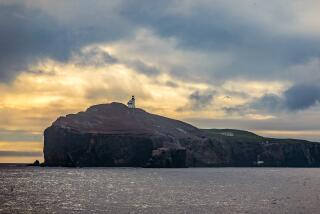Photographer’s Portfolio: Galapagos Islands : Day of the Iguana
- Share via
It was like setting foot in a prehistoric scene, or perhaps, on another planet, says Times photographer Veronika Andrasovsky of her trip last December to Ecuador’s Galapagos Islands. What she found in those Equatorial isles was surface-of-the-moon topography--fields of twisted lava that erupted from the sea 4 million years ago. She also found animal life so untainted that it still trusts humans. In short, a photographer’s dream.
Dragon-like land iguanas--the only ones in the world--drew close enough to touch. Curious mockingbirds landed on spectators and peered into camera lenses. Visitors watched as mothers, just a few feet away, pushed their baby sea lions into shallow waters for swimming lessons.
From the 83-foot motor yacht Eric, customized to sail the Galapagos, Andrasovsky and a friend joined a dozen other travelers and a crew of 10, including two guide-naturalists who lectured each evening. They explored many of the Galapagos’ 13 major and six minor islands and found each to have its own unique ecology, often with endemic species of plants, birds, animals and insects.
On one island, they nearly stumbled upon an albatross nested in an open field, the young one looking like a big cotton puff. And, of course, there were the tortoises for which the islands are named and that served for centuries as meat for pirates and early settlers, who nearly destroyed the population.
But not every moment was plump with natural beauty. At the Charles Darwin Research Station on Santa Cruz Island, home to various breeding programs to preserve the tortoises, Andrasovsky saw Lonesome George, the giant tortoise who can never mate to carry on his lineage because he is the sole survivor of his subspecies.
More to Read
Sign up for Essential California
The most important California stories and recommendations in your inbox every morning.
You may occasionally receive promotional content from the Los Angeles Times.













